 |
 |
Updated 2004-06-09 Swedish version |
 |
 |
Updated 2004-06-09 Swedish version |
| Rackelhanen Other names used for this fly: Polysedge, Rackelhahn, Honk Originator: Kenneth Boström in 1967
Back to Flytying indexpage |
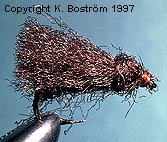 |
![]()
| Kenneth Boström tells us about
history, fishing technique and shows us the original tying description for Rackelhanen. History
|
| Fishingtechnique. During the years I have developed many different fishing methods with Rackelhanen. I will try to describe the most important methods here. Rackelhanen almost always is fished in the surface and with a floating line. But at certain times it could be better to choose a sinktip line. A Rackelhane should always be treated with a floating substance. Many people have misunderstood the quality of polypropylene, and believe that it floats well without treatment, but it won't! Caddis have many different ways of hatching. These ways must we, as fishermen and -women know how to imitate. The Rackelhane makes a blurry silhouette when it is looked at from underneath against the sky. This is most likely the best explanation why the Rackelhane is so efficient. The material gives the impression of life, and the caddi is never still either on or in the water, in contrast to the mayfly. Technique 1. Stripping on the surface. Short and "nervous" pulls, 2 inch long, with a short pause between them. This imitates the behavior of egglaying or drinking caddis Technique 2. When I see the fish eating "swimming" "paddling" caddis pupae on the water, I usually cut of the wings on Rackehanen and present it as a surface swimming pupa heading for land. Technique 3. A/. Let the leader sink - you can gladly use a sink tip line with a short tip. B/. Pull the line so that the fly drags under the water surface. C/. Make a short pause, and the fly floats up again with a plopping sound. This technique gives a perfect imitation of a caddis that is hatching just below the surface Technique 4. You can also fish Rackelhanen completely free floating as a dry fly - imitating a spent caddis. During the years I have tested the Rackelhanen on many different species of fish, e.g. trout, char, rainbow trout, cutthroat, grayling and many more, both here in Europe and in USA. Everywhere the fish have taken my fly with the same confidence and trust as Swedish trout. Because of this I strongly believe that you can find it worth your while to try Rackelhanen on your next fishing trip. Flyfishing greetings from: Kenneth Boström
|
| Material for Rackelhanen are: fly tying
thread, a light hook size 10-18 and polypropylene yarn in any of the following colors:
brown, olive, light ginger, grey or white, you can also mix these colors with each
other.Try to use the colour that imitates your local caddi flies best.
|
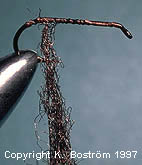 |
Use a prewaxed thread of the same color as the rest of the fly. Cover the shank with thread down to the bend, turn here and wind a couple of mm in the opposite direction. Wax the thread thoroughly, dub it with 1 cm long cut pieces of polyyarn that you have fluffed up |
![]()
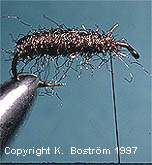 |
Wind the two first turns down against the bend. Here you turn and wind in the opposite direction. This way you can trap the fibers from the first turns (otherwise it's difficult to have these stay in the right position) down under the body material. Remember to leave space for the wings and front body. |
![]()
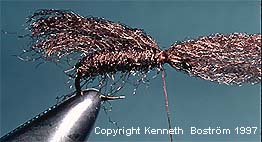 |
Cut a piece of the poly yarn and use the right amount of fibres for the hooksize you are using. Tie the yarn on to the hook as shown in the picture. |
![]()
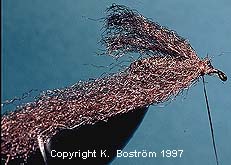 |
Fold the other winghalf backwards and fasten it with a couple of thread turns over the wingbase. Remember to leave enough space for head and frontbody. |
![]()
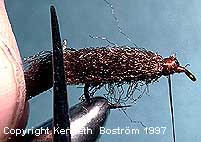 |
Trim the wings by cutting them just behind the hook bend. Important that you don't make them too long. |
![]()
 |
Dub the thread again with 10-20 mm long bits of fluffed poly yarn and tie the front body. Finish the fly by making a small head with tying thread. You can varnish the head if you feel like it but it isn't necessary, because we used the prewaxed thread. |
© Pictures and text, Kenneth
Boström 1995
Updated 2004
![]()
Back to Flytying
indexpage
Back to patterns and tying descriptions indexpage
|
||||||||